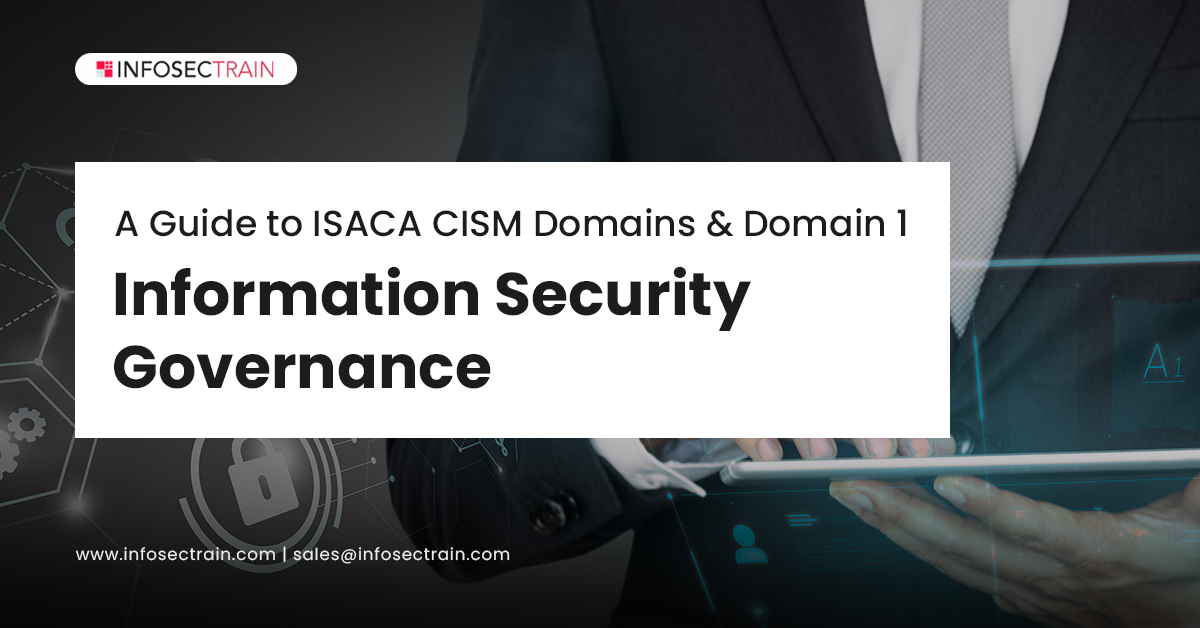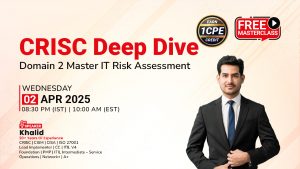A Guide to ISACA CISM Domains & Domain 1: Information Security Governance
The Certified Information Security Manager certification validates and proves your knowledge and experience in developing and managing an enterprise information security program.

CISM is mainly designed for individuals who want to land in positions like Information Security Analysts, IT managers, or consultants supporting information security management. A CISM-certified professional is also expected to develop practices and policies, manage information security, and understand the relationship between business objectives and information security.
When you are willing to learn CISM, you have to focus on the domains of CISM mainly. And here are the domains.
Domains of CISM:
- Information Security Governance
- Information Risk Management
- Information Security Program Development and Management
- Information Security Incident Management
In this blog, we will discuss CISM domain 1 Information Security Governance.
What is Information Security Governance?
The National Institute of Standards and Technology (NIST) defines Information Security Governance as the process of establishing and managing a framework that ensures that information security strategies are aligned with business objectives and comply with applicable laws as well as regulations by following standard policies and internal controls.
In its simplest form, Information Security Governance entails good risk management, reliable reporting controls, comprehensive training and testing, and rigorous corporate accountability. In addition to providing direction for cybersecurity activities, it ensures the company’s security objectives are effectively met.
Working of Information Security Governance
CISOs and other chief executive officers typically oversee governance within an organization. With the help of senior management and security professionals, board members, CXOs and executives identify information assets and information security risks, create a strategy for securing information systems and the data they contain, and develop information security policies that cover everything from access controls to organizational security awareness.
Using a governance framework is crucial for ensuring that the organization’s policies, procedures, and practices adhere to regulations and standards. The most popular Information Security Governance frameworks include:
- National Institute for Security and Technology (NIST) publication 800-53
- The Payment Card Industry Data Security Standard (PCI DSS)
- Control Objectives for Information and Related Technology (COBIT)
- International Organization for Standardization (ISO) 27001
- The Health Information Portability and Accountability Act (HIPAA)
Information Security Governance is more crucial than ever. According to recent Nominet data, 66 percent of firms had at least one security breach in the previous year, with 30 percent experiencing several breaches. Nominet discovered in its 2020 CISO Stress Report that CISOs ranked the duty of safeguarding their organization and its network as the most stressful aspect of their job. According to the paper, “since the pace of cybercrime shows no indication of slowing down, this stress is being compounded by the growing frequency of cyber events.”
So, here are a few tips to follow in order to stay on top of Information Security Governance demands:
Select a better framework: The first step in becoming an expert in your organization’s information security programs-or its lack thereof-is to select a framework, such as ISO or COBIT. An information security framework can serve as a guide for implementing processes and procedures across an organization and prevent the use of haphazard approaches.
Take a close look at the IT infrastructure:
It is very important to have a close look at your IT infrastructure, and you have to concentrate particularly on how servers and firewalls are configured. Review your server configurations and firewall rule sets. If you do not have any pre-plan to review these devices, make it your priority. You will also have to set up a process and timeline for penetration testing and run vulnerability scans on your network. Penetration testing and vulnerability scans are the starting points for any investigation into your technology.
Establish an Information Security Governance committee:
What to do after successfully developing the policies? Policies should also be thoroughly reviewed by key stakeholders, not just the IT and security staff.
Set up an information security governance committee that includes legal, auditors, HR, and C-suite representatives. The inclusion of people with different (non-IT) perspectives is important when developing policies. The governance committee finalizes all policies, which then creates the roadmap for the management and training of information security programs.
Develop training programs:
The majority of employees aspire to do the right thing. If you tell them what they need to do, they’ll usually do it. All you have to do now is spell out the business procedures and expectations.
Audience-based security awareness training can go from left to right and from top to bottom. You must customize the material for various audiences. For example, if you’re speaking to a highly technical IT audience, you’ll need to explain the security standards that apply when setting up servers or routers. You may need to discuss password length and complexity as well as how to recognize phishing and social engineering techniques for non-technical audiences.
If you are excited to learn more about CISM, join infosecTrain for the best lectures.
Why InfosecTrain?
- As ISACA is our premium training partner, our trainers know how much and what exactly to teach to make you a professional.
- InfosecTrain allows you to customize your training schedules; our trainers will provide one-on-one training.
- You can hire a trainer from Infosec Train who will teach you at your own pace.
- One more great part is that you will have access to all our recorded sessions.
That sounds exciting, right? So what are you waiting for? Enroll in our CISM course and get certified. Here you can get the best CISM domain training.







 1800-843-7890 (India)
1800-843-7890 (India)